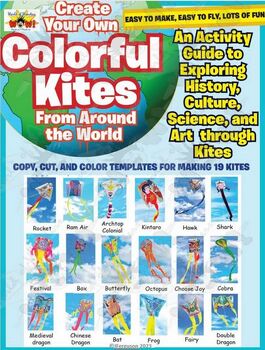Colorful Kites From Around the World - DIY Stem/Steam Projects for Kids
WOW - World of Wonders
9 Followers
Grade Levels
K - 8th, Homeschool
Subjects
Resource Type
Standards
CCSSK.G.A.2
CCSSK.G.A.3
CCSSK.G.B.6
CCSS3.G.A.1
CCSS4.G.A.3
Formats Included
- PDF
Pages
192 pages
WOW - World of Wonders
9 Followers
Description
Great DIY copy paper kite projects that include science, math, engineering, art, literature, history and world cultures (STEM, STEAM.) Learn about the forces behind flight with easy instructions, inexpensive materials, and cut and color templates for 19 kites from around the world. Includes directions for how to prep kites for a classroom/youth group.
Included in this product:
- History of kites
- How to prep kites for a crowd
- Flight instructions and safety
- Parts of a kite
- The science of kite flight
- Experience the science of balanced and unbalanced forces while kite flying
- Engineering design (aerodynamics) and symmetry
- How to read the wind - Beaufort wind scale for kite flying
- Troubleshooting tips
- World of kites coloring page
- Literature links
- Black and white and color templates for 19 kites
- Clear photo instructions for making each kite
- Multicultural stories, filled with traditions from many lands, all celebrating the universal joy of kite making and flying.
Total Pages
192 pages
Answer Key
Does not apply
Teaching Duration
Lifelong tool
Last updated Mar 18th, 2023
Report this resource to TPT
Reported resources will be reviewed by our team. Report this resource to let us know if this resource violates TPT’s content guidelines.
Standards
to see state-specific standards (only available in the US).
CCSSK.G.A.2
Correctly name shapes regardless of their orientations or overall size.
CCSSK.G.A.3
Identify shapes as two-dimensional (lying in a plane, “flat”) or three-dimensional (“solid”).
CCSSK.G.B.6
Compose simple shapes to form larger shapes. For example, “Can you join these two triangles with full sides touching to make a rectangle?”
CCSS3.G.A.1
Understand that shapes in different categories (e.g., rhombuses, rectangles, and others) may share attributes (e.g., having four sides), and that the shared attributes can define a larger category (e.g., quadrilaterals). Recognize rhombuses, rectangles, and squares as examples of quadrilaterals, and draw examples of quadrilaterals that do not belong to any of these subcategories.
CCSS4.G.A.3
Recognize a line of symmetry for a two-dimensional figure as a line across the figure such that the figure can be folded along the line into matching parts. Identify line-symmetric figures and draw lines of symmetry.





